----
Car seats. When used correctly, they save lives. I wanted to take a minute and go over some common errors that can have tragic results in a collision. PLEASE- take a few minutes to read through this and pass it along!
First off, let me introduce myself. My name is Angela Waagen. I am a full time firefighter and paramedic. I am a CPST (child passenger safety technician). I am a mommy to three daughters. I have seen firsthand the difference a correctly used child safety seat can make in a wreck. The problem is that fewer than 5% of them are used correctly. I want to personally encourage every parent to have their install inspected by a CPST. (Make sure they are certified. Don't be afraid to ask for their card or numbers. Many parents assume that any policeman or fireman should know how to install car seats, but in order to get certified there is a 32 hour class. Do not let anyone who says "yeah, I have a couple kids, let me help you out" anywhere near your car seat! Your child's life depends on it!)
"What's the "safest" seat for my child?"
There is no "safest" seat. Unfortunately car seats either pass or fail a stringent test (FMVSS213). If they pass, they go on store shelves. The best seat is the one that fits your vehicle, fits your child, and is installed and used correctly on EVERY ride.
Infants-
Infants ride rear facing. Parents can use either a carrier type seat that may or may not snap into a base (check your manual- some seats require use of the base, others do not) or a convertible seat. Most convertible seats are too big for newborns, since for rear facing, the shoulder straps MUST be AT or BELOW the shoulders.
Carrier type seats can have weight limits ranging from 20-35lbs. A car seat is outgrown when baby either reaches the weight limit, or when there is less than 1" of hard shell over the baby's head. (Measure perpendicular to the car seat shell, NOT parallel to the ground)
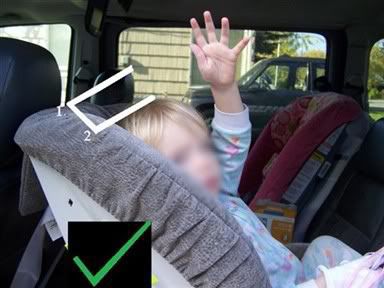
"What about those cute little strap covers/soft fuzzy insert/pillow things?"
Do not add anything to the car seat that did not come with it. Such aftermarket items are NOT approved (FMVSS213) and can drastically alter the way the harness holds your child in during a collision.
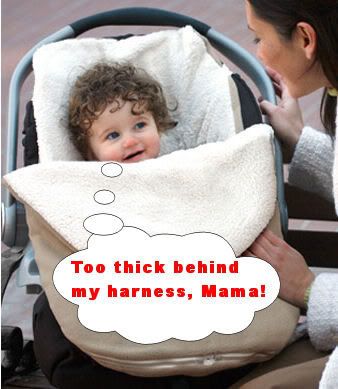
"How about the coat? It's cold outside!"
Thick coats are not to be used in the car seat. To tell if your coat is too thick, strap the child in with it on. Then, remove the coat and secure the child again. If you now have slack in the harness, the coat is too thick. A fleece blanket works well over the harness, or you can put a hood less coat on backwards over baby after they are strapped in. (If you can't buckle the straps, it's too thick!)
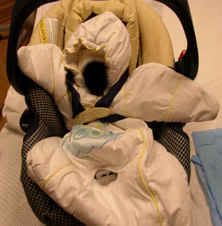
"How do I tell if the harness is too loose?"
Most parents fail to tighten the harness enough. The harness will give and stretch in a crash, so it needs to be snug. If you can pinch the harness near the child's shoulders lengthwise, it is too loose.
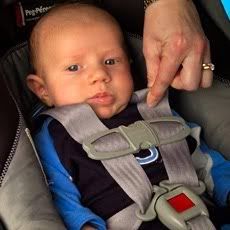
"What about that little plastic clip? What does it do?"
That is the chest clip. (It belongs at armpit level no matter the age of the child. Please take care to keep it off the belly- it's not a belly clip!) This is considered to be a pre-crash positioner, and it's job is to make sure the shoulder straps stay on the shoulders before a crash, so the harness can do it's job.
"My baby is outgrowing his carrier- what now?"
Well, you need to find a convertible seat, and keep baby rear facing. The absolute bare minimum to legally turn a child forward facing is 12 months AND 20 pounds. However, legal and safe are two very different things. Which brings us to....
"When can I turn them forward facing? Their legs are bent. Their feet are touching the seat. They want to see, etc."
Consider this- the job of the car seat is to protect the child, right? In a collision, the harness holds the body in. In a forward facing seat, the head is thrust forward violently. The head of a toddler usually makes up 25% of their total body weight (that would be like a 200 pound adult having a 50 pound head!) It is 500% safer to keep them rear facing AS LONG AS POSSIBLE! This provides the ultimate protection for the head, neck, and spinal cord. The bones of the neck can stretch up to 2" before they break. The spinal cord itself only needs 1/4" stretch to cause permanent damage, paralysis, or death. Keeping a child rear facing distributes the forces of a collision evenly down the child's back, and simply pushes them deeper into their seat, instead of flinging the head forward. Take a look at this 3 minute video, paying close attention to the difference it makes in actual crash testing:
http://www.youtube.com/watch?v=kRP7ynNI8mI
"What if I get rear-ended? Isn't that the same as a forward facing seat hitting something on the front?"
No. If you get rear ended, chances are that you were stopped or even moving forward at the time of the wreck. For it to have the same physics you would have to hit something in reverse. How often do you drive in reverse at highway, or even city speeds?
http://myangelsaliandpeanut.tripod.com/id5.html
"But is it really that dangerous to turn them around? My baby is big and I think he's ready to face forward"
Yes. It really is that dangerous
http://www.youtube.com/watch?v=Q8gU9zzCGA8
"But what about my pediatrician? My doctor said he could turn around now" Unfortunately there is just too much continuing education to keep up with all the newest info, and doctors are superb at sore throats, runny noses, appendicitis, and the likes. Doctors are not the ones in the streets showing up on the firetrucks and ambulances, and picking these kids up. Fortunately, the AAP does work with other agencies, and since 2002 the AAP has had this stance on extended rear facing:
"Children should face the rear of the vehicle until they are at least 1 year of age and weigh at least 20 lb to decrease the risk of cervical spine injury in the event of a crash. Infants who weigh 20 lb before 1 year of age should ride rear facing in a convertible seat or infant seat approved for higher weights until at least 1 year of age.3,4 If a car safety seat accommodates children rear facing to higher weights, for optimal protection, the child should remain rear facing until reaching the maximum weight for the car safety seat, as long as the top of the head is below the top of the seat back."
Most pediatricians are simply not aware of the newer recommendations, and revert back to the old 12 months/20 pound recommendation.
"Won't they be unhappy riding backwards that long? What about their legs?"
Legs can be fixed. Necks can't. Here is my youngest- 3 years old and safely rear facing (at 32 pounds. Her seat has a rear-facing limit of 45 pounds, so she has a while to go yet.)
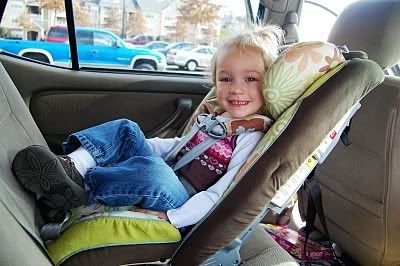
Older toddlers-
Those who have outgrown their rear-facing seats, can go into a forward facing seat, but they must still use the 5 point harness until they are ready for a booster. For forward facing, the same guidelines apply about harness tightness and the position of the chest clip, but for forward facing, the harness straps need to be AT or ABOVE the shoulders. Years ago forward facing seats had a harness weight limit of a standard 40 pounds. Seats how have higher weight limits, and higher harness heights, to accommodate keeping a child in a harness longer. Many seats now harness to 65 or even 80 pounds, and will fit a child until they are mature enough (read- mature enough, not "big" enough) to ride in a booster seat.
"Won't an older child feel ridiculous in a "baby" seat?"
Not necessarily. As a mom, there are some issues that are simply not up for debate. Safety is one at my household. Trauma kills more children every year than any other cause of death, and motor vehicle crashes are the leading cause of that trauma to our children. You cannot predict an accident, but you can take steps to keep your children as protected as possible in every ride.
When using a forward facing seat, secure the top tether whenever possible. Vehicle came standard with top tether anchors sometime around 1999/2000. This is an anchor point either on the back dash, on the back of the vehicle seat, on the floor behind the seat, or even the roof of some SUV's that has an image of a boat anchor and child seat on it. Sometimes parents confuse a cargo anchor point with a tether anchor. Only a tether anchor with the anchor image is intended for use with child seats- please consult the vehicle owner's manual. Some vehicles- especially pick up trucks- want you to route the top tether strap under a headrest then to an anchor point NOT directly behind that child safety seat's position in the vehicle. Using the top tether reduces head excursion- the amount the head moves forward in a crash. Even a properly secured car seat will move forward violently in a crash, and too much head excursion will allow your child's head to strike the front seat

"How do I install my seat in my vehicle?" First- consult both the manual of your vehicle, and the manual of your car seat. Read both extensively!!! You can use either seat belt or LATCH to install your child's seat, but NEVER BOTH. Use whichever is easier for you to get a good, solid install in your vehicle. Depending on the car seat and the contours of your vehicle seat, one may work better than the other (at ease of installation). Neither is "safer" than the other. Using both together is NOT approved to do. This puts too much stress on the seat and can cause it to fail.
When installed, your seat should not move more than one inch at the belt path. Make sure to lock the seat belt into place if using seat belt installs, and DO NOT "borrow" latch anchors to "make" a center latch position if the vehicle does not specifically state that there are center latch anchors. The latch anchors are two small bars (that you clip the seat to). Each of those two small bars are attached to one long bar inside the vehicle seat. If you steal the middle most anchor from each outside latch, it's similar to going to the gym, and trying to lift 20 pounds by picking up one end each of two, ten pound dumbbells. It distributes the weight unevenly and will not perform correctly in a crash.
Keep in mind that there are weight limits to latch- some vehicles specify 40 pounds, others 48, some refer back to the child seat manufacturer. Check the manuals for guidance.
Another thing to consider is that car seats DO expire. They are made of plastic, and are subjected to extreme temperatures. When I hear parents say "oh that's just a marketing ploy" I ask them to visualize a plastic lawn chair left on the porch for a few seasons, then visualize an adult jumping onto it. During a crash that plastic seat will be subjected to hundreds, if not thousands of pounds of pressure. Most seats have a 6 year lifespan- again check your manual.
Older children-
"Is my child ready for a booster seat? The box says it fits kids 30 pounds and over"
A child may be heavy enough according to the box, but manufacturers are required to put weight limits on their seats. There is a huge difference both physically and physiologically between a 30 pound 18 month old, and a tall but skinny 30 pound five year old. In order for a booster to do it's job, the child MUST be able to stay in position for the entire ride. They must be mature enough not to reach over for a dropped toy, turn around for a sudden noise, or fall asleep and slump over. Most children are not mature enough for a booster until 5 or 6 years of age.
"My child is too big for a booster. They can ride in just the seat belt now".
Probably not. The adult seat belt does not fit most children until 10 or 12 years of age. Children need to pass the 5 step test in order to ride in just the adult belt-
1.- Does the shoulder belt cross the collar bone, not the neck?
2.- Does the lap portion ride low, over the hip bones and thighs, not over the belly?
3.- When scooted all the way back in the vehicle seat, do my child's knees bend at the edge of the vehicle seat?
4.- Are my child's feet flat on the floor?
5.- Can my child stay like this for the entire ride?
If any of the answers are no, then your child still needs a booster seat. A booster raises the child's pelvis up and allows the belt to fit them properly. This ensure that in a wreck, the strongest skeletal parts absorb more of the impact than the vital internal organs that would otherwise be damaged by the seat belt. Please take the time to read through this for a better understanding of older kids and boosters:
http://carseatblog.com/?p=3966
Finally- after a crash, destroy your seat- it has done it's job!!!!
Thank you for taking the time to ensure your child is protected! It can make all the difference between saying "wow I am so glad we took the time to....." or "if only we had stopped and...." after an accident! For more car seat info:
http://car-seat.org
For help with your seat, feel free to contact me at awaagen@yahoo.com or go here to find a CPST in your area:
https://ssl13.cyzap.net/dzapps/dbzap.bin/apps/assess/webmembers/tool?pToolCode=TAB9&pCategory1=TAB9_CERTSEARCH&Webid=safekidscertSQL







5 comments:
Thanks for posting this! I am trying to convince my sister to rear face longer...it just makes so much more sense!! BTW, we need to get together sometime. I have your Fuzzi Bunz. =)
Great post! I could do to show this to a few people. Currently in 'discussion' with dh over whether to move my daughter to a stage 2/3 car seat - she is well over the minimum height & weight, but I will not move her until she's OVER the maximum weight for her stage 1 seat. One day he'll realise that it's just not up for discussion!
I've also had a lot of 'bad mummy' comments when I won't put my little one in thick winter coats in her car seat. My explanations about compromising safety fell on deaf ears, so I'll keep this article handy in case it comes up again!
There are lots of things I let my kids get away with when people say I'm crazy. It doesn't bother me when they climb all over stuff in the house even if it's "not safe." What's going to happen really?
But car seat safety is another matter. They WILL be strapped in tightly, properly, rear-facing every time in every car. They will never use a booster at all if I can help it, because they'll still be in a 5-pt. harness until 65 lbs. (and if they're not over age 8 I guess they'll have to go in a booster). Bekah is 2, 26 lbs. and rear facing. Yes, she's tall and her legs are kicking and pushing on the seat and people comment about how she must be uncomfortable. They also ask why I put thin, warm fleece coats on my kids instead of "real" puffy winter coats. I don't care. My kids are SAFE.
While working as a paramedic, our truck was dispatched to a single car accident. Upon arrival we found a Pontiac Grand Am overturned in a front yard. Front and side airbags had deployed and the driver was being attended to by the first responding fire department. Tragically, the "car seat/carrier" being used had failed. During the crash, the various forces of impact resulted in the separation of the carrier from its base and the ejection of the child from the vehicle. The vehicle came to rest on top of the child, causing injuries, which were fatal.
I'll never forget the sight of her little hand pressed into the mud, anti-freeze and broken glass.
Now that I have two children of my own, I refuse to use the "car seat/carrier" safety seats. The only seats that are used are one piece Britax units secured to a LATCH anchor point.
It is simply not worth the convenience to be able to pick up the car seat carrier from its base knowing that in a crash, the seat could separate from the base.
Great post and incredibly thorough.
Post a Comment